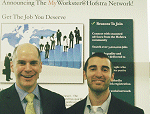2009 Campus Technology Innovators: Social Networking
- By Mary Grush, Matt Villano
- 08/01/09

HOFSTRA AND MYWORKSTER worked together to create a Facebook-like
system that would be fun and user-friendly. Pictured: Hofstra's Fred Burke
(left) and MyWorkster's Jeffrey Saliture (right).
SOCIAL NETWORKING
Innovator: Hofstra University
This Long Island school is providing tools and services to
foster strong adviser relationships among its community
of students and alumni, to help increase job placement
for students in today's difficult economy.
Given the current economic climate, there is a real need for
creating relationships that facilitate the exchange of professional
opportunities with and amongst university communities.
With that in mind, Hofstra University (NY) set out to provide
tools and services to foster strong adviser relationships
among its students and alumni.
MyWorkster@Hosftra users
can connect with advisers in
a variety of media: text chat,
video, audio, and more.
"Hofstra has a community of well established, successful
alumni who are eager to give back in the form of professional
advisership," says project lead Fred Burke, executive director
of the school's Career Center. "The difficult thing was finding
a system like Facebook that was fun, familiar, simple, and
made people want to use it."
For two years, the Career Center worked with professional
network technology provider
MyWorkster to develop MyWorkster@
Hofstra, an online social networking
service that enables alumni
advisers to mentor current and past students alike. The site
debuted in March 2009, and has succeeded in bringing
together Hofstra constituents in an environment that fosters
online mentoring, builds community, and extends the university's
brand in the marketplace as a whole.
Jeffrey Saliture, CEO of MyWorkster, likens the system to
"Facebook for professionals; like eHarmony but for jobs," and
says the interface combines the most popular social networking
technologies of the day. "People can use this the same way
they're using other Web 2.0 sites, allowing them to connect to
people who will help them get a job," he says. "What gives the
interface appeal is that it's familiar, yet targeted for a purpose."
Here's how the system works: First, an alum registers to
become an adviser, providing his or her name, alumni ID number,
preferred method of contact, and other information. The
data are then sent to the university for approval before the registrant
becomes a part of the MyWorkster@Hofstra community.
Once alumni have been certified, they can answer
questions about anything from the current job market, to how
to find a job in a particular industry or niche.
Alumni advisers are available 24 hours a day, seven days a
week. Students can search for advisers based on location,
industry, and company, to find the mentor who they think will
work best for them. Users can connect with advisers in a variety
of media: text chat, video, audio, and more. The site utilizes
technology from Meebo (for instant messaging) and Skype (for internet voice and video calling), and interfaces easily with
general-interest sites such as Facebook and LinkedIn.
Though the service is relatively new, positive feedback indicates
the technology is benefiting a variety of constituents.
Users appreciate the guidance from advisers; alumni are able
to give back to the Hofstra community. When advisers help
users find new jobs, the university benefits from an increased
presence in the marketplace.
As an added plus, university officials can download all of the
data from the system (e-mail addresses, contact info, employer
info, etc.) and use it to populate internal databases. At Hofstra,
the Career Services department downloads the data into
SunGard Banner Unified Digital Campus, allowing various
departments to leverage the information for a variety of
purposes. "The university relies on this system to maintain
better contact and employment data on its alumni," Burke
points out. Such up-to-date information is invaluable for
donor relations, for instance, which ultimately fills coffers
in the school's endowment and benefits technology investments
across the board.
About the Authors
Mary Grush is Editor and Conference Program Director, Campus Technology.
Matt Villano is senior contributing editor of this publication.